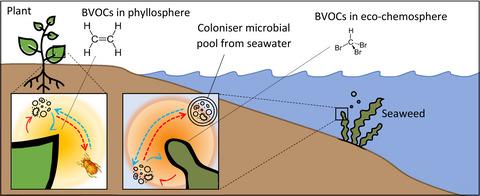Our official English website, www.x-mol.net, welcomes your feedback! (Note: you will need to create a separate account there.)
Volatile-mediated interactions with surface-associated microbes: A parallelism between phyllosphere of plants and eco-chemosphere of seaweeds
Journal of Ecology ( IF 5.5 ) Pub Date : 2021-05-17 , DOI: 10.1111/1365-2745.13693 Mahasweta Saha 1 , Pauline Gilon 1, 2 , François Verheggen 2
中文翻译:

挥发性介导的与表面相关微生物的相互作用:植物叶际与海藻生态化学圈之间的平行关系
更新日期:2021-05-17
Journal of Ecology ( IF 5.5 ) Pub Date : 2021-05-17 , DOI: 10.1111/1365-2745.13693 Mahasweta Saha 1 , Pauline Gilon 1, 2 , François Verheggen 2
Affiliation

|
- Both in terrestrial and aquatic realms, organisms communicate and interact with each other via volatile and non-volatile infochemicals. Terrestrial plants and seaweeds, known as prolific producers of volatiles, harbour a plethora of microbes on their surfaces like phyllosphere of plant leaves and eco-chemosphere of seaweeds, respectively, where complex ecological interactions are regulated through infochemicals.
- Although plant leaf volatiles have been well-studied for their ecological functions in mediating microbial interactions, seaweed volatiles have been mostly investigated for their roles in climate regulation and with regard to climate change research. However, seaweed volatiles appear to be related to terrestrial plant volatiles both in terms of chemistry and ecology.
- Synthesis. Evidence supports that seaweed volatiles can have important ecological functions in mediating interactions with microbes on their surface, just like plant leaf volatiles. Based on the existing vast literature on ecological interactions mediated by plant volatiles at phyllosphere and on the very few works on ecological roles of seaweed volatiles at eco-chemosphere, we advocate for the detailed investigation of volatile-mediated interactions regulating microbial colonisation processes on seaweed surfaces. Although of great ecological importance, this new field of research has remained largely unexplored. Thus, we also set directions for future research programs investigating the roles of seaweed volatiles at seaweed–microbe interface.
中文翻译:

挥发性介导的与表面相关微生物的相互作用:植物叶际与海藻生态化学圈之间的平行关系
- 在陆地和水生领域,生物体通过挥发性和非挥发性信息化学物质相互交流和相互作用。陆生植物和海藻被称为挥发性物质的多产生产者,它们的表面分别存在大量微生物,如植物叶子的叶际和海藻的生态化学圈,其中复杂的生态相互作用通过信息化学物质进行调节。
- 尽管植物叶片挥发物在介导微生物相互作用方面的生态功能已得到充分研究,但海藻挥发物主要因其在气候调节和气候变化研究中的作用而受到研究。然而,海藻挥发物在化学和生态学方面似乎都与陆生植物挥发物有关。
- 合成。有证据表明,海藻挥发物在介导与其表面微生物相互作用方面具有重要的生态功能,就像植物叶片挥发物一样。基于现有的大量关于叶际植物挥发物介导的生态相互作用的文献和极少数关于海藻挥发物在生态化学圈中的生态作用的研究,我们主张详细研究调节海藻表面微生物定植过程的挥发物介导的相互作用. 尽管具有重要的生态意义,但这一新的研究领域在很大程度上仍未得到探索。因此,我们还为未来研究海藻挥发物在海藻-微生物界面上的作用的研究项目设定了方向。



























 京公网安备 11010802027423号
京公网安备 11010802027423号